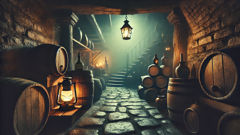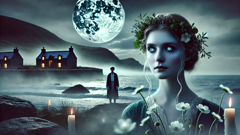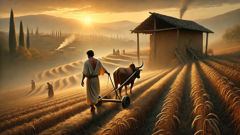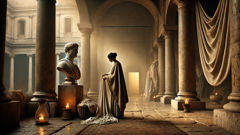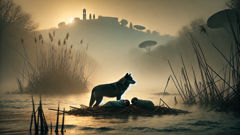Introduction
Under the worn cobbles of Warsaw's Old Town, where merchants once dragged barrels of rye and amber traders argued over prices, there was a world the sunlight barely touched: a mesh of cellars and undercrofts stitched beneath timber and brick, filled with barrel staves, clay jars, sacks of grain, and a damp perfume of earth and old wine. In that under-city the air tasted of iron and moss, and footsteps above sounded like distant waves. For a long time, neighbors told one another small superstitions about that darkness: not to leave your latch unfastened at night, to carry a coin when passing a cellar hatch, to avoid staring at the black corner beneath the stairs. Such habits can seem like fuss to an outsider, but superstitions are often shorthand for memory; they are the community's way of saying, we have seen something and we remember. It began with a single missing child's name scratched on a door lintel, then a man who went down to fetch a forgotten ledger and did not come up. When the first suspected victims were found, turned as if struck by a sudden frost and as still as stone, the city’s gossip braided itself into fear. People whispered of a basilisk—an ancient creature whose gaze kills or turns flesh to marble—because once, long ago, fear had taken such a shape, and names travel faster than proof. The basilisk, they said, had nested where the city kept its forgotten things: among barrels of salted herring and jars of pickles, where the light bled thin and rats kept their private courtyards. To speak of it was to summon memory; to ignore it was to risk more being added to the ledger of the missing. Traders from the Vistula markets stopped coming at dusk. Lamps burned all night along Piwna and Nowomiejska. Mothers kept babies close, and men who once boasted about the sturdiness of stone found themselves counting the number of stone-faced neighbors on their strolls. The stone faces multiplied—an old miller midstride, a seamstress bent forever over a phantom seam, a tavern boy frozen with a tankard uplifted—and each statue was a mute indictment of the cellar's evil. Yet even as fear fanned across the city like dry straw, people did not surrender entirely to terror. They gathered in small clusters along the walls, traded theories and remnants of courage, and remembered that monsters, however terrible, could sometimes be outwitted by strange, everyday tricks. It was in that brittle seam between dread and stubbornness that our story begins—a story of cobblestone cellars, of hollow laughs turning to silence, and of a small, improbable plan hatched by an apprentice who believed that a mirror and a rooster could save an old city.
The City Beneath the Cobblestones
At the heart of Warsaw's Old Town, the city lived in layers. Up above, the market bell punctuated the day and the square filled with voices—women bartering linen, men hauling cartloads of grain, children racing with wooden hoops. Beneath those noises, however, was a quieter commerce of its own: cellars where merchants kept furs in winter and onions in summer, where spiced wines aged in darkness and pickling vats breathed a vinegary sweetness into the stone. These spaces were practical, crowded, and strangely personal; families carved initials into beams, lovers pressed coins into mortar, and every so often, someone would fashion a small shrine by the foundation stone to keep bad luck at bay. The cellars were also the city's secret arteries: when the snow buried the streets, a wise baker could borrow a neighbor's back stair to reach the ovens; when fevers took a house, bellies could be fed through tunnels and shared stoops. Yet those passageways had corners that had not met daylight in decades and places where humidity drew ghostly veins on brick.

People who grew up in the Old Town had learned to navigate an invisible map, recognizing the small cues—the uneven brick where a rat had tunneled, the dampness that always meant a pooled leak—to avoid trouble. Still, as winter loosened and the city began to move again, odd reports emerged. A cooper, Marek of Piwna, went down to fetch a particular cask of honey wine in the grey of an afternoon and never returned. His wife waited by the stair and finally descended, calling for him in a voice that turned brittle in the cold. There, near the back wall among the stacked staves, Marek stood as if in prayer but his expression lacked warmth; his skin had assumed the pale sheen of river rock. Word moved with the speed of gossip and the stubbornness of denial. Some insisted it was a cold snap, some blamed a strange mold, but the pattern hardened as more victims were found: a seamstress working late, a lantern-carrying apprentice, a young boy who had chased a cat into a cellar for a lost ribbon. Each was found immobile, their eyes open in the way the city had learned to dread. And in the fissures between grief and practical questions, a name came back from the shelves of older tales: basilisk, that old European rumor of a serpent crowned and terrible, whose gaze could turn flesh to stone.
Legends like that have curious persistence. They are handed down partly because they explain what we do not want to understand, partly because they are good stories at the hearth. The basilisk became a shorthand for all that was ugly and unstoppable about a calamity. Stories spread that the creature had come from the foundations of an old manor that once stood beyond the river, that it had been born from the accidental meeting of a cursed egg and a cat, that it preferred the cool air of cellars where people kept the city's small intimacies. Scholars and clergy came and went: some offered prayers and relics; others tried to seal the cellars with plaster and chain. But stone responds to weather, not sermons, and the petrified remained as stubborn as the old mortar. The affect of the basilisk's presence was not only the physical transmutation of flesh into stone. It was the way the city's rhythm adjusted—traders moved their business to daylight markets on the riverbank; children stayed closer to the baker’s door; the municipal watch changed its patrols. Fear reshaped daily life, and in that reshaping people began to notice small practical details they had once ignored: the way the basilisk seemed to favor certain aromas—briny fish, ferments left to linger—or how its attacks clustered near the older row houses whose foundations sat lower in the soil. The pattern of panic is never purely irrational: it is a map.
In such tight quarters, where neighbors could hear one another’s whispers through cellar beams, courage takes odd forms. Years of living in proximity create favors owed and small debts paid. It led a handful of people—an apothecary’s apprentice named Ania, an old cooper called Marek, and a taciturn miller, Janek—to meet in a cramped back room and compare notes. They pooled jars of herbs, old mirrors that had lost frames but kept glass, and lamps with glass lenses spare enough to magnify a candle's flame. None of them were heroes by trade. Ania ground balms for coughs and bruises; Marek made barrels and named each by the kind of grain they once held; Janek spoke to his horse more than to other men. Yet they all understood the same thing: monsters that can be observed can sometimes be out-thought. If the basilisk was indeed a creature whose gaze had power—if that gaze was line-of-sight and specific in its cruelty—then perhaps the city could use sight as a weapon. They tested small ideas by candlelight. Mirrors, they observed, catch and throw back light and image; roosters, the village wise women murmured, were creatures of dawn whose cry unsettled certain night-born things. These were humble tools, not swords or holy relics, and that humility, in the end, proved to be the city's most accurate weapon. The decision to act was not made in a single dramatic council; it was hatched in the tiny space between panic and practical ingenuity, a plan to lure and reflect, to trick a sight-based predator with its own reflection and to amplify confusion with the crowing of a bird long associated with the morning and with the turning of the night to day. Community is often the most reliable reagent in a crisis: neighbors watched one another's houses, shared food, and traded superstition for experiment. They took their tools—an old coachman's mirror, a borrowed lantern, a rooster on loan from a stubborn widow—and walked down the stone steps into the place the city had come to dread. That descent would decide whether Warsaw kept its living neighbors or traded them for a garden of silent statues.
The Night of Stone and the Clever Trick
The plan was not a grand one. It was practical, low on pomp and high on improvisation—qualities that belong to neighborhoods rather than palaces. Ania, the apothecary's apprentice, had suggested the mirror. She'd handled vials and ointments and knew how an image could trick a beast as surely as a false scent might lure a hound. Marek, the cooper, had brought an old convex shaving mirror, its silvering flaked but its curve still willing to return a face. Janek had procured a lantern with spare glass and a handful of pitch to keep the wick steady. The widow, Rozalia, had agreed to lend a thin, stubborn rooster that crowed at dawn and sometimes before, as if anxious to conjure the day. They patched together their plan on a bitter evening when frost etched lace on the outside windowpanes and the city's lamplighters moved like ghosts along the streets.
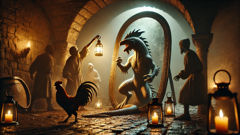
At dusk, the small band descended beneath the cobbles. Their route threaded past houses with shuttered windows and beneath archways where ivy sheltered from the wind. One by one they crept into the chosen cellar—the one nearest to the mill where most of the recent changes had been recorded. The air there tasted of old bread and metal. As they set the lantern down, light bled along the damp mortar and the shadows rearranged themselves, becoming a language they read without words. The mirror was propped at the angle Ania thought most likely to capture the basilisk's approach; it reflected the lantern's glow and a slice of the cellar's arch. Then they waited. Waiting in such places has its own peculiar character: every creak becomes significance, every drop of water a potential herald. Ania felt her knuckles pale as she held a small vial of alum, clutched as talisman more than as a medicine.
The basilisk came exactly as the story of monsters often prescribes: not in a paroxysm of violence but as a stealthy slide of a shadow. It was not a serpentine prank of mere scales but a creature assembled from rumor and the city's darkest corners—long-limbed, with a head set like a crown of horns, eyes that seemed to drink the reflected light rather than to shine with it. Its movements were silent and slow, as if it regarded the world with a consideration usually reserved for curiosities. When it lifted its head and regarded the team in the lantern's glow, those who saw were seized by a cold so pure it felt like being underwater; breath hitched, the marrow of courage thinning until instinct was all that remained. Janek's hand sought Marek's shoulder, Marek gripped the mirror like a shield, and Ania remembered every short prayer she had heard from neighbors on winter nights. The basilisk's gaze met the mirror's surface. For a second, everything seemed to hold its breath: the creature, the lantern, the tiny congregation of townsfolk, the cellar itself. The mirror, imperfect and curved, caught and rebounded the image of the basilisk. The creature blinked—then, as the legends promised and the old stories had warned and the people had half-doubted, it recoiled as if it had seen an enemy far worse than any human.
What happened next was a furious, shimmering trick of reflex: the basilisk saw itself and, in a reaction the townspeople later described as tragicomic, began to wither into a statue of its own making. Its scales paled to a matte stone, its horns crystallized like salt frozen in a tide pool, and a shock of dust like frost fell from its ribs. Yet even as the creature's stony transformation began, the team realized that nevertheless it could still move, if only to collapse and shudder. The mirror fractured under the strain with a thin, human sound as Janek jerked it, and Rozalia's rooster, startled by the sudden motion and the shape of that collapsing thing, let loose a scream that broke across the cellar like a bell. That cry—simple and ordinary and stubbornly human—seemed to do something more. The basilisk's remaining motion stilled as if the sound had been an insistence of morning itself; its head slumped and the last living shine of its eye dulled as though closing for a sleep that would never end. When the dust settled, what lay in the pool of lantern light was not a living terror but a statue fashioned in the precise, terrible pause of life. It was monstrous and also, in a strange way, finally mute.
Warsaw did not forget the details. Stories attach themselves to proof, and proof in this case could be walked around and shown to skeptical eyes. The statue remained for days in the cellar under guard, and skilled hands—masons who had worked on towers and chimneys—examined the surface and found the petrification curiously like natural stone, heavy beyond measure. The city's leaders debated what to do: hide it, destroy it, or display it as a talisman. In the weeks after, there were other small effects that people attributed to the basilisk's defeat. The market regained some of its daylight bustle; traders returned to their evening routes; children began again to skip along the ribs of the old bridges. But more enduring than any single victory was the pattern of how the community had responded. The coopers and apothecaries, the widow and the miller, had demonstrated a kind of civic ingenuity that didn't rely on weapons or on a single heroic figure. They used knowledge—about light, about animal behavior, about how rumors and myth can sometimes be treated as hypotheses to be tested. Their plan married superstition and science in a way that felt, to the people, like an admirable cunning rather than a sacrilege.
Legends like to decorate endings with moral clarity. In the retellings that gathered in the taverns after, the story emphasized that courage could be crafted from the humblest materials: a cracked mirror, a tired lantern, a rooster's ordinary insistence on morning. Schoolchildren learned the tale not only as horror but as a lesson about sharp thinking and communities that watch for one another. Travelers who visited the Old Town were shown the very cellar where the statue had lain—now a dusty curiosity under careful planks—and told that the basilisk had been defeated not by swords or edicts but by neighbors using what they had. There are other versions told in other towns, as folktales do, each with a different implement of defeat—a mirror here, a crowing rooster there, a hero with holy water somewhere else. But when Warsaw tells the story, it keeps the detail of the cellar, the barrels, the roving trader who gave them the first hint of trouble, and the apprentice who believed a mirror could act like a third eye. It remembers the names of the people who took small risks so the city could remain whole. And it remembers that the city's stones—both the ones that were turned and the ones that held up the houses—had borne witness to both fear and the stubborn, neighborly wit that overcame it.
Conclusion
In the years that followed, the basilisk of Warsaw became more than just an episode of terror; it became a story the city told itself when it wanted to remember that fear can be answered with thought as well as with pikes. Statues and shrines change hands over generations: a figure once feared can be moved, displayed, or buried; a mirror can become a child's plaything; a rooster can become the subject of a nursery rhyme. Yet the core of the tale remained: neighbors who shared small resources and applied common sense had turned back a monstrous force. That is as much a civic moral as a folktale can claim—an insistence that communities are made by small acts of courage and by the willingness to test strange ideas against the hard fact of survival. The cobbles above those cellars were repaired with a careful hand, new lanterns fixed in alleyways, and a line of lanterns was kept by the municipal watch for a long time after, more to remind than to defend. Ania went on to run a modest apothecary where she kept a narrow mirror behind glass, not as an ornament but as a reminder that looking carefully sometimes saves lives. Marek continued to build barrels, and Janek kept his horse and spoke to it by the riverbank. Their names entered the city's small litany of ordinary heroes. For visitors now, the Old Town's cellars are part memory and part museum, and the story of the basilisk circulates as a legend polished by retelling. Yet if you stand at dusk on the edge of the square and lean close to the manifold of voices—sellers calling prices, gulls crying near the river—there is a small quietness beneath the clamor, like the hush under a lid that has been lifted. It is there, in the long and practical breath between the cobbles and the cellars, that Warsaw keeps the memory of what it took to turn a gaze back upon itself and end the cold spell. The moral is not a thunderbolt but a low, persistent light: cleverness, community, and the courage to look closely—these are what keep a city alive.

